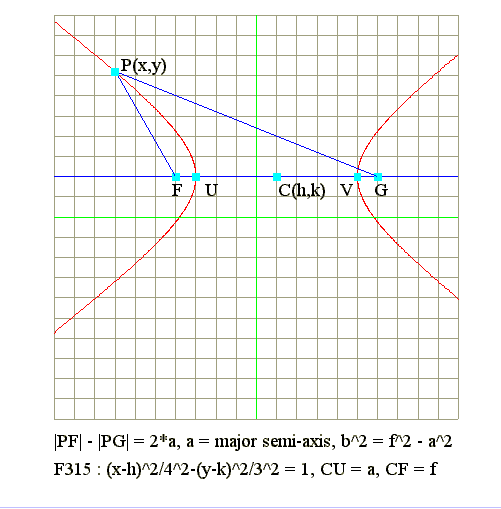-
Q01 |
- Diagram : (x/a)^2 - (y/b)^2 = -1
- Q02 | - Properties of (x/a)^2 - (y/b)^2 = -1
- Q03 | - Study ((x - 1)/4)^2 - ((y - 2)/3)^2 = -1
- Q04 | - Study Parametric equations : x = sec(t) and y = tan(t)
- Q05 | - Reference
- Q02 | - Properties of (x/a)^2 - (y/b)^2 = -1
Q01. Diagram : (x/a)^2 - (y/b)^2 = -1

|
Go to Begin
Q02. Hyperbola : (x/a)^2 - (y/b)^2 = -1
Properties of the curve
- It is a hyperbola
- The openning is up in 1st and 2nd quadrant
- The openning is down in 3rd and 4th quadrant
- The principal axis is x = 0
- The vertex : (0, b) and (0, -b)
- The focal length is f = Sqr(a^2 + b^2)
- The foci (0, f) and (0, -f)
- Domain : all x
- Range : y > b and y < -b
- Asymptotes : b*x = a*y or b*x = -a*y
Go to Begin
Q03. Study the curve of ((x - 1)/4)^2 - ((y - 2)/3)^2 = - 1
Question :
- 1. Find focal length f
- 2. Find principal axis
- 3. Find asymptotes
- 4. Find Coordinates of vertex and foci
- 5. Find domain and range
- 1. Find f
- Since a = 4 and b = 3
- Hence f = Sqr(a^2 + b^2) = 5
- 2. Principal axis is x = 1
- 3. Asymptotes
- 3*(x - 1) = 4*(y - 2)
- 3*(x - 1) = -4*(y - 2)
- 4. Vertex and foci
- Let center be (h, k). Hence h = 1 and k = 2
- xu = h = 1 and yu = k + b
- xv = h = 1 and yv = k - b
- xf = h = 1 and yf = k + f
- xg = h = 1 and yg = k - f
- 5. (y - 2)/3 = Sqr((x - 1)/4)^2 + 1)
- y = 3*Sqr((x - 1)^2 + 16)/4 + 2
- Domain : All x values
- Range for +Sqr:
- x = 1 y = 5 is minimum
- y is from 5 to +infinite
- Range for -Sqr:
- x = 1 y = -1 is minimum
- y is from -1 to -infinite
- The y values : y < -1 and y > 5
Go to Begin
Q04. Parametric equation : x = sec(t) and y = tan(t)
Parametric equations
- Equivalent to (x/a)^2 - (y/b)^2 = 1
- x = h + a*sec(t)
- y = k + b*tan(t)
- Equivalent to (x/a)^2 - (y/b)^2 = -1
- x = h + a*tan(t)
- y = k + b*sec(t)
- Q1. Describe the curve
- Q2. Describe the curve between t = 90 to 180 degrees
- Since 1 + tan(t)^2 = sec(t)^2
- Hence 1 + y^2 = x^2
- It is hyperbola x^2 - y^2 = 1
- a = 1 and b = 1
- Hence f = Sqr(a^2 + b^2) = Sqr(2)
- Vertex : (-1, 0) and (1, 0)
- Foci : (-Sqr(2), 0) and (Sqr(2), 0)
- Principlal axis is y = 0
- Find equation of directrix (See polar form)
- sec(90.0001) = -infinite and tan(90.0001) = -infinite
- sec(180.000) = -1 and tan(180.0) = 0
- Hence the curve is in 3rd quadrant
- The curve is from (-infinite, -infinite) to (-1, 0)
- Since this hyperbola opens to right and left
- Hence the curve is concave upward
- Hence we know that y' is positive and y" is positive
-
Parametric
equations
Go to Begin
Q05.
Reference
Go to Begin
